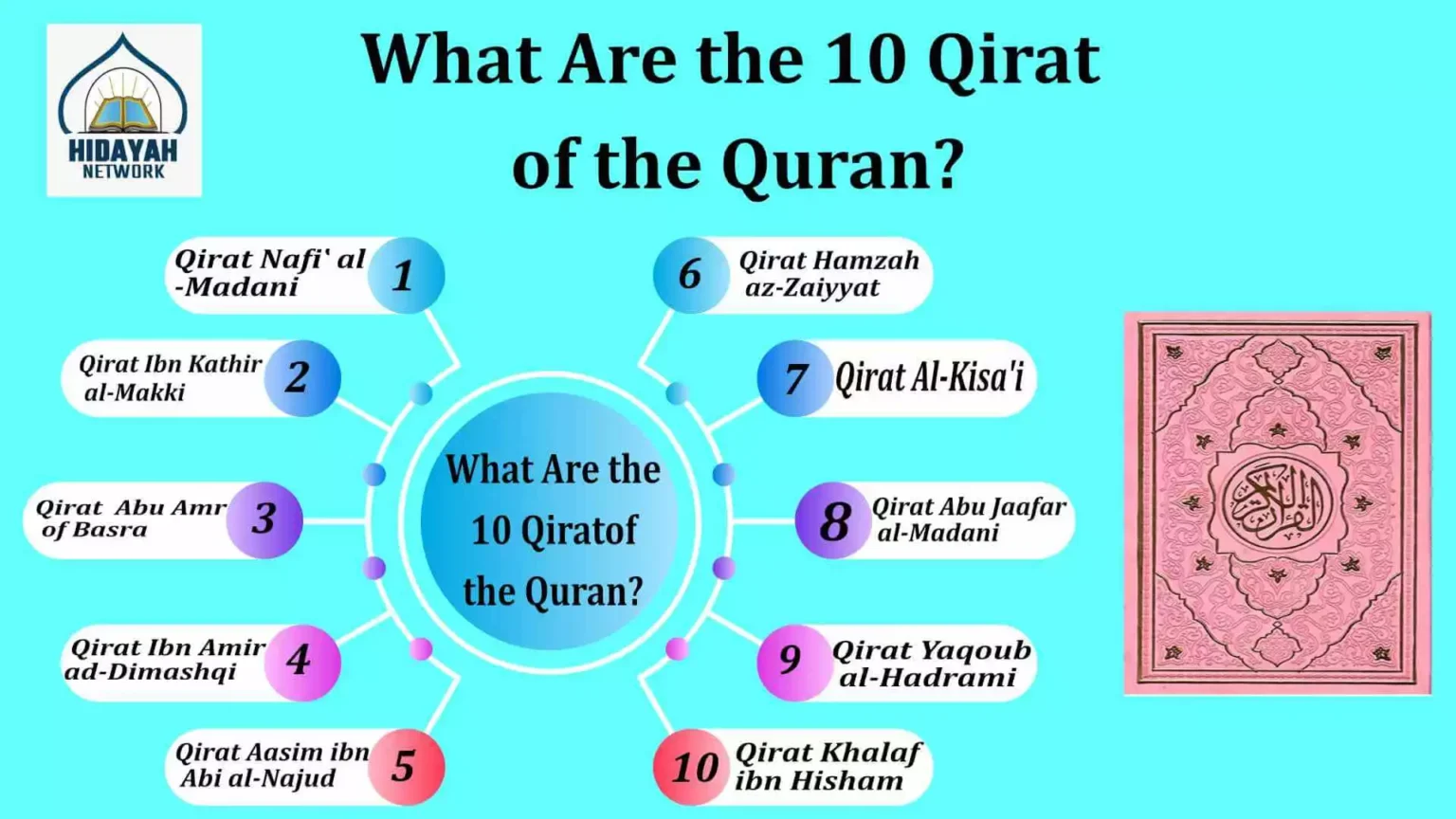What Are 10 Qirat of Quran Recitation?

- Hidayah
- Network
- | Role: Hidayah Network

Quranic recitations, known as Qirat, reveal a profound aspect of Islamic heritage. The ten Qirat represent diverse ways of reciting the Quran, each stemming from an authentic chain of transmission traced back to the Prophet Muhammad (PBUH). These variations in pronunciation and intonation hold significance in linguistic nuances and in preserving the Quran’s pristine message.
The 10 Qirat of the Quran is Qirat Nafiʽ al-Madani, Qirat Ibn Kathir al-Makki, Qirat Abu Amr of Basra, Qirat Ibn Amir ad-Dimashqi, Qirat Aasim ibn Abi al-Najud, Qirat Hamzah az-Zaiyyat, Qirat Al-Kisa’I, Qirat Abu Jaafar al-Madani, Qirat Yaqoub al-Hadrami, and Qirat Khalaf ibn Hisham. We will help you understand everything related to the Qirat of the Quran and how each one preserves the Quranic message. Let’s get started!
Table of Contents
ToggleWhat is a Qirat of the Quran, and Why Does It Exist?
The term “Qirat,” originating from the Arabic word “Qirah,” translates to ‘reading’ in English, specifically referring to the recitation of the Quran. This concept has undergone extensive scrutiny among Quranic scholars, with one interpretation defining it as the knowledge of correctly pronouncing the verses of the Quran. It is intricately tied to the title ‘Qari,’ denoting one who recites the Holy Quran.
The existence of multiple Qirat of the Quran stems from the linguistic diversity inherent in the Arabic language. The Quran, revealed in Arabic, reflects the linguistic nuances in various Arabic dialects, each distinct in vocabulary, grammar, and pronunciation. Recognizing this diversity, canonical transmitters of the Quran adapted its recitation to align with the dialect of their respective communities.
The Prophet Muhammad (peace be upon him) endorsed and embraced these dialectal and accent variations, signaling that the acceptance of different styles of Quranic recitation is not only permissible but also a testament to the linguistic richness embedded in the revelation. The acceptance of diverse Qirat is deeply rooted in the Prophet’s practice, enabling us to learn to recite Quran beautifully.
Get 40% OFF Now!
How Many Qirats of the Quran Are There? [The Truth About It]
The Quran is recited in 10 different ways, a consensus that most Islamic scholars and Shuyukh (Sheikhs) agreed upon. Initially, Abu Bakr Ibn Mujahid, in his book Kitab al-sabʿa fil-qirat, recognized only 7 distinct Qira’at.
However, the list expanded to 10 when Ibn al Jazari added three more reciters. This number discrepancy arises from the evolving recognition of varied recitation styles within the Islamic scholarly tradition.
Each Qira’at, totaling 10, further unfolds into two Riwayah, signifying that every Qirah Master has two distinct Ravi. Riwaya, Turuq, and Wujuh also play a role to recite the Quran like a pro Qari.
10 Types of Qirat of the Quran
| Name of Qirat | Its Explanation and Significance |
| Qirat Nafiʽ al-Madani | Qirat Nafi Al-Madani stems from the recitation of Naafi Al-Madani, one of the seven transmitters of the Quran. Naafi belonged to Al-Madina in Saudi Arabia, and this Qirat reflects the linguistic nuances of the city. Widely approved by Islamic critics and philosophers like Al-Durr and Al-Nasai, Naafi’s recitation is considered trustworthy. Two direct transmitters, Qalun and Warash, further popularized Naafi’s Quranic recitation, with Qalun being personally taught by Naafi and Warash, an Egyptian, adopting Naafi’s style. |
| Qirat Ibn Kathir al-Makki | Qirat Ibn Katheer Al-Makki, developed by Ibn Katheer, aligns with the linguistic system of Mecca. The recitation has two transmitters, Al-Buzzi and Qanbal, both of Persian origin, facilitating communication. This Qirat represents a distinct style influenced by the linguistic characteristics of Mecca, contributing to the rich diversity of Quranic recitations. |
| Qirat Abu Amr of Basra | Abu Amr Al-Basri’s recitation is acclaimed for its eloquence and resemblance to the companions of the Prophet. Abu Amr, well-educated and claiming unmatched knowledge, received education from renowned Islamic tutors. His recitation is considered reliable by many Islamic scholars, solidifying its significance in Quranic studies. |
| Qirat Ibn Amir ad-Dimashqi | Qirat Ibn Aamir Ashami follows the linguistic variation of Syria, as he served as the Imam of the mosque of Damascus. Transmitted by Hisham and Bin Dhakwan, this Qirat represents the distinct linguistic features of the Syrian region during the reign of Al-Walid Bin Abd Al-Malik. |
| Qirat Aasim ibn Abi al-Najud | Qirat Asim Al-Kufi reflects the linguistic system of Al-Kufa, which was learned from Abd-Alrahman Al-Sulami. Two notable reciters, Hafs and Abu Bakr, transmitted Asim’s Qirat, contributing to its acceptance and approval by many Islamic scholars. |
| Qirat Hamzah az-Zaiyyat | Qirat Hamzah Al-Kufi, influenced by the Kufi dialect, received both support and criticism. Transmitted by Khalaf Bin Hisham and Khallad Bin Khalid, the recitation acknowledged Hamzah’s proficiency as an Arabic grammarian. |
| Qirat Al-Kisa’i | Qirat Al-Kisai Al-Kufi, developed by Al-Kisai, became prominent in Kufa after the death of Hamza. Transmitted by Al-Layth Bin Khalid and Hafs Bin Umar, the recitation is recognized and deemed reliable by Islamic scholars. |
| Qirat Abu Jaafar al-Madani | Qirat Abu Jaafar, widespread in Al-Madina, earned its place among the 10 accepted recitations. Transmitted by Isa and Ibn Jammaz, Abu Jaafar’s recitation holds significance in Quranic studies. |
| Qirat Yaqoub al-Hadrami | Qirat Yaqoub Al-Hadrami, while accepted among the 10 recitations, faced objections from some critics. Transmitted by Ruways and Ruh, Yaqoub’s recitation is associated with esteemed and hard-working tutors. |
| Qirat Khalaf ibn Hisham | Qirat Khalaf Bin Hisham Al-Baghdadi, approved by Islamic scholars, is characterized by its trustworthiness. Transmitted by Ishaq and Idris, both recognized as reliable transmitters, Khalaf’s recitation adds depth to the diverse tapestry of Quranic recitations. |
Understanding the Different Between Qirat and Tajweed
The distinction between Qirat and Tajweed is crucial for understanding the proper recitation of the Quran. Qirat refers to the various traditional methods of recitation, encompassing the diverse styles in which the Quran was revealed. On the other hand, Tajweed comprises a set of rules that guide the correct pronunciation and recitation of the Quran.
It’s important to note that each Qirat has its corresponding Tajweed rules. The significance of Tajweed is emphasized in the Quranic verse (Al-Baqarah:121), which underscores the proper reading of the Book. Those who read the Quran with Tajweed, adhering to the prescribed rules, demonstrate their belief in its divine message, while the verse warns that those who neglect Tajweed risk losing the essence and beauty of the sacred text.
Learn and Improve Your Qirat with the Help of Quran Tutors at Hidayah Network
Enhance your Quranic recitation skills and fluency with the dedicated Quran tutors at Hidayah Network. Offering online Quran recitation lessons, this platform provides a structured and personalized approach to help learners refine their Qirat. Whether you’re a beginner seeking to establish a strong foundation or improving fluency in Quran recitation, Hidayah Network’s experienced tutors offer guidance and support, making the learning process accessible and effective.
Final Words
Understanding the nuances of Qirat and Tajweed is paramount in mastering the art of Quranic recitation. Qirat represents the diverse traditional methods of reciting the Quran, while Tajweed provides the essential rules ensuring proper pronunciation and rhythm. Each Qirat carries its distinct Tajweed, highlighting the intricate beauty of the Quran’s oral transmission.
Most Important FAQs
The most popular Quran Qirat is Hafs An Asim, which is widely adopted and memorized due to its simplicity and prevalence among Muslims globally.
To read the Quran with Qirat, one can start by learning the basic rules of Tajweed, ensuring proper pronunciation and rhythm. Seeking guidance from a qualified Quranic tutor can further enhance the understanding and mastery of Qirat.
Qirat in Salah refers to reciting specific verses or chapters from the Quran during the prayer. Muslims incorporate Qirat into their daily prayers, following the prescribed recitations in a way that aligns with the chosen Qirat style, often Hafs An Asim.

About Author
Related Blogs
Dive Deeper into Related Topics
